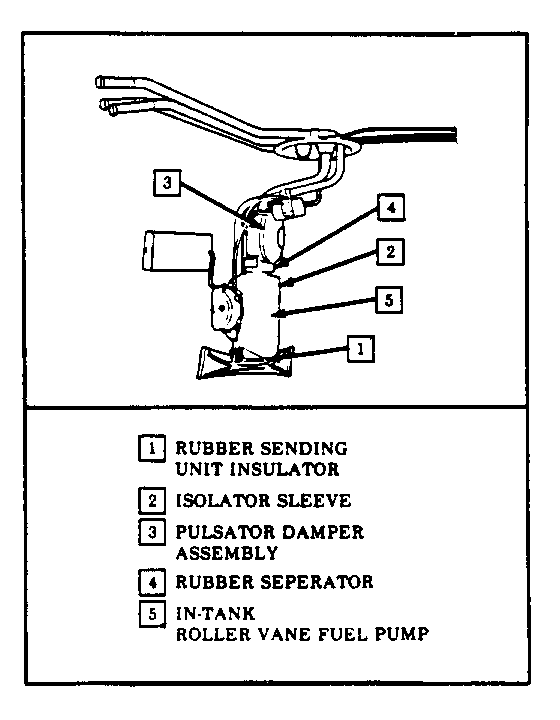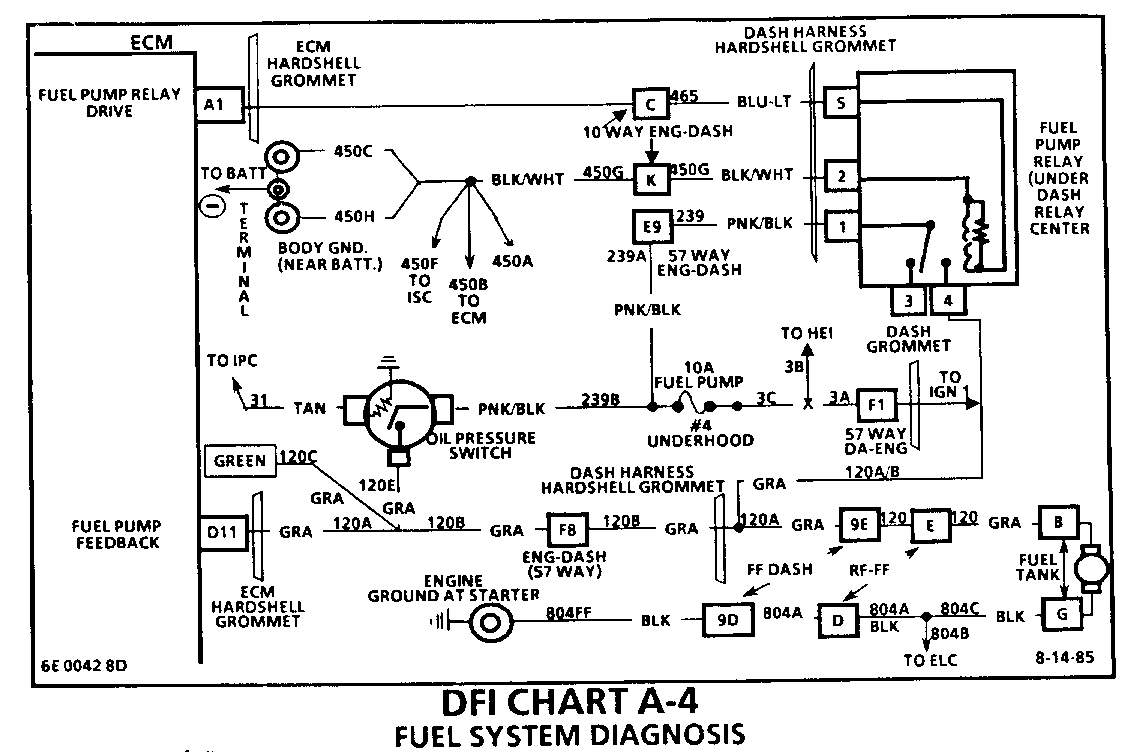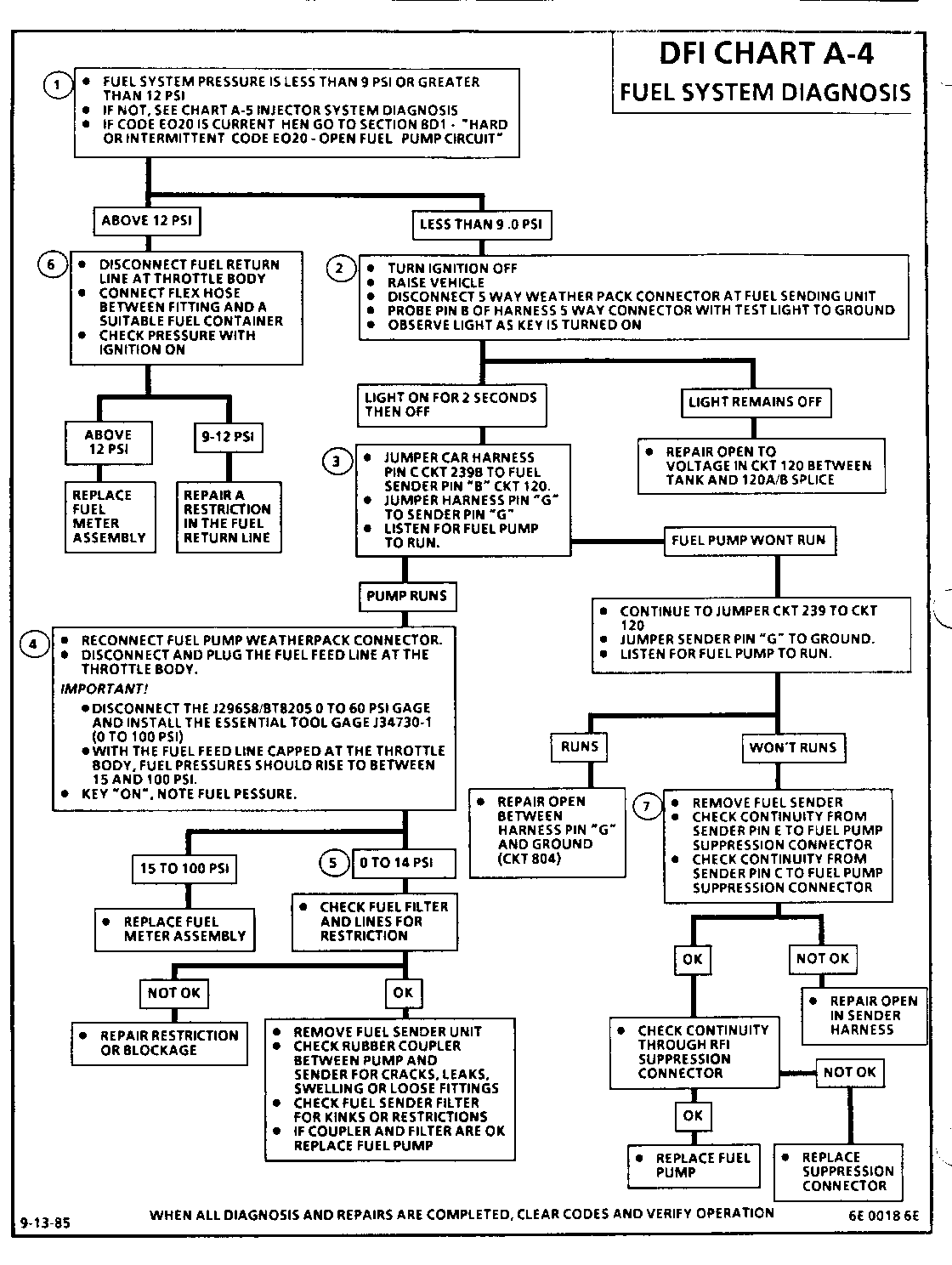REVISED FUEL PUMP DIAGNOSIS AND REPLACEMENT PROCEDURE

MODELS AFFECTED: 1936 ELDORADO AND SEVILLE
1986 Eldorado and Seville models are equipped with a roller vane fuel pump. This fuel pump is designed to achieve a much higher deadheaded (i.e., fuel return line restricted) pressure than the fuel pumps used previously and on other models equipped with DFI. For this reason, the return fuel line must not be restricted under any circumstances, including diagnosis, or damage to the fuel pressure regulator may result.
To avoid the possibility of damaging the fuel pressure regulator during diagnosis, please mark the following Eldorado/Seville Service Information Manual pages to make reference to this bulletin until a looseleaf revision page is received:
Page 6E-A-16,6E-A17 Page 6C-4 (Figure 6C-6)
The revised pages are attached and the changes have been shaded to highlight the differences.
In addition, the removal and installation procedure has changed to accommodate the transfer of parts to the pump being installed. There are four noise suppression devices used with the roller vane pump which must be assembled to the replacement pump. Failure to assemble the noise suppression parts to the replacement pump may result in owner comments about excessive noise. For warranty purposes, use Labor Operation number L1200 at 1.2 hours. The parts to be assembled to the sending unit are as followss (see Figure 1):
DFI CHART A-4 FUEL SYSTEM DIAGNOSIS
Notes on Fault Tree:
1. The fuel pressure gage J-25400-300 should be installed at the fuel line service fitting. Measure the fuel pressure while cranking the engine. If the fuel pressure is between 9.0 and 12.0 psi, then refer to the performance diagnosis chart A-5 "Injector System Diagnosis".
2. If the fuel pump relay or ECM were the cause of a low fuel pressure, there would be an ECM code E020 set. This step is to check for voltage supply to the fuel tank four-way connector.
3. If the voltage signal to the fuel tank connector is OK, then an open may exist between the four-way fuel tank connector and the fuel pump. If fuel pump runs with an alternative power source connected, the fuel tank unit is OK; check throttle body fuel metering assembly for cause of low pressure.
IMPORTANT
Before performing step 4, disconnect the J29658/BT8205 to 60 psi gage and install the essential tool gage J37730-1,0 to 100 psi gage.
4. Checking for fuel supply system (tank, filter, pump, sender, supply line) able to deliver adequate pressure. The 1986 eldorado and Seville use a positive displacement fuel pump. With the fuel feed line plugged, the fuel pressure should rise to between 15 and 100 psi. If pressure is OK with the feed line capped, then the fuel meter pressure regulator is at fault, replace the fuel meter assembly.
5. If pressure is low with fuel feed line plugged, then throttle body fuel metering assembly is not at fault. A restriction or blockage may exist in the fuel supply system. The fuel supply line should be checked visually for kinks, damage, etc; the fuel filter element can also restrict fow. Check for proper fuel line routing as shown in Section 6C under the heading "Fuel Tank and Fuel Lines". Check sender tubes for restrictions, check for rubber coupler between pump and sender leaking or restricted, check for fuel strainer in tank collapsed, mispositioned or restricted. If all of the above are OK, replace the fuel pump. See Section 6E.
6. Fuel pressure above 12.0 psi is caused either by a malfunction of the pressure regulator or by a restriction of the pressure regulator or by a restriction in the fuel return line. To isolate the cause of the high fuel pressure, disconnect the return line at the throttle body and connect a suitable fitting to the throttle body which iwll accept a length of flexible rubber fuel hose. Insert the other end of the hose into a suitable fuel container and observe the fuel pressure as the ignition switch is turned on. If the fuel pressure remains above 12.0 psi, replace the fuel metering assembly. It is unable to control pressure properly.
If the fuel pressure drops into the correct pressure range of 9.0-12.0 psi, with the fuel return line bypassed, then the fuel return line is restricted. A restricted fuel return line can be diagnosed by visually inspecting the line for kinks, damage, etc. A kink in the Teflon fuel line (braided stainless steel clad) may not be visually obvious.
7. If the fuel pump will not run with externally applied power, the fault is an electrical open in the fuel sneder unit wiring to the pump, an open at the RFI suppression connector inside the tank on the pump or a faulty fuel pump. The fuel sending unit must be removed from the vehicle to check.
A looseleaf Service Manual revision incorporating these changes is to follow.



General Motors bulletins are intended for use by professional technicians, not a "do-it-yourselfer". They are written to inform those technicians of conditions that may occur on some vehicles, or to provide information that could assist in the proper service of a vehicle. Properly trained technicians have the equipment, tools, safety instructions and know-how to do a job properly and safely. If a condition is described, do not assume that the bulletin applies to your vehicle, or that your vehicle will have that condition. See a General Motors dealer servicing your brand of General Motors vehicle for information on whether your vehicle may benefit from the information.
